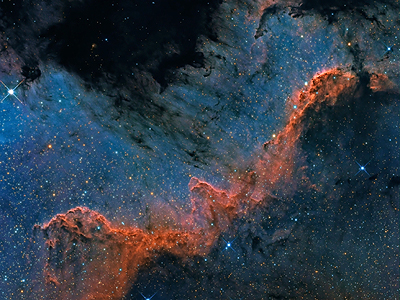|
Because Thomas chose to capture emission nebulae, using of
narrow-band filters brings great effect. It is true, that the amount
of light passed by these filters is very low, so a sensitive CCD
camera and many hours long exposures are necessary to achieve good
signal-to-noise ratio. But the light from these nebulae is not a
result of high temperature, like in the case of stars (or candle flame
or classic bulb tungsten filament), but it is emitted by certain atoms
only and thus it has very specific wavelength. So narrow-band filter
significantly lowers the amount of light captured from thermal sources
(stars), but almost all light from the nebula reaches the sensor. The
result is the nebulosity is enhanced relative to stars (and other
sources, like light pollution brightening our night sky).

The first image is a part of a larger nebula with catalog
designation NGC7000, called “North America” in Cygnus.
According to our geographical analogy, the part shown spans the
majority of Mexico (the Gulf of Mexico is on top). Detailed image
shows the gaseous nebula pressed by intense stellar radiation of young
stars. Interstellar gas then creates filaments and trunks. This part
is also called the “Cygnus Wall”. The dark part on the top of
the image with much less stars is in fact very similar cloud, but we
see it from the back side. It is very probable the opposite side of
the cloud, facing the bright stars, looks very similar to Cygnus Wall,
which we can see from the side.
The image is composed from exposures captured thought narrow-band
Hα, OIII and SII filters as well as through
standard Red, Green and Blue filters. Total exposure time is 23
hours.
Another narrow-band image from Thomas shows the NGC6888 nebula
called “Crescent Nebula”, also in Cygnus. The nickname
originated when the first images, taken on classical films, revealed
the nebula shape similar to crescent. But modern cameras are much more
sensitive than films and show much dimmer parts of the nebula, so the
crescent shape somewhat disappears.
The nebula is formed by intense radiation of a very hot star in the
nebula center designated WR136 (such hot stars are named Wolf-Rayet
stars after their discoverers).
As there is almost no SII emission in this nebula, Thomas used only
Hα and OIII filters for narrow-band data.
Total exposure time is 22 hours.
| 